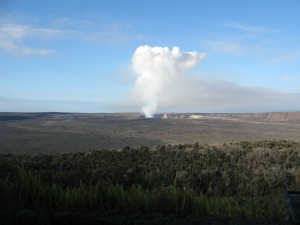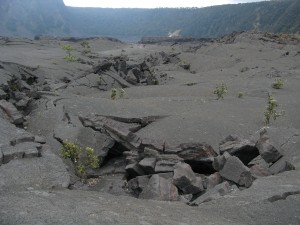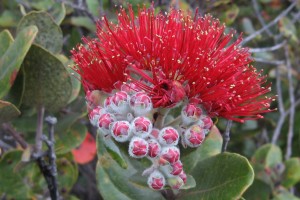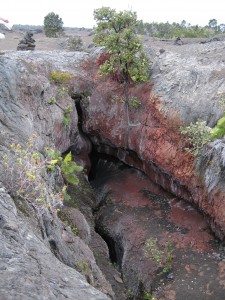The Park
The first time I went to Hawaii Volcanoes National Park I was disappointed. There were no snow capped peaks and fields of wildflowers. Instead there was a ragged gray landscape that went on as far as the eye could see. What one can witness here is the latest building of the Hawaiian islands. Seventy million years ago a hot spot opened on the seafloor. Lava poured out and, over time, built the first Hawaiian island. The newly built land moved west, away from the hot spot. As more lava poured out, another island was formed. The island moved westward and the process continued. You can tell the relative age of a particular Hawaiian island when you look at a map: Kauai is the oldest and the islands get younger as they move down the chain towards the Big Island. The seafloor eruption continues today. When you look at the volcanic gas plume rising out of Halema’uma’u Crater inside Kilauea Caldera, you are seeing the same force that made all the islands. Besides the erupting volcanoes and endless lava fields, the park has forested areas that help protect the dwindling numbers of native plants and animals. There is a lot to explore including trails to the coast and trails to the summit of Mauna Loa.
My Experience
I visited the park around fifteen years ago. Things had changed since that visit. I started my 2014 tour of the park at the first stop on Crater Rim Drive called Steam Vents. As I stepped out of my car, I was greeted by a warm touch of volcanic steam. Along both sides of the road, pillars of white stream rose in contrast to the gray lava. Something was definitely going on inside the earth beneath my feet. I walked down to the overlook of the Kilauea caldera. During my past trip, I’d walked across the caldera floor. Now a white gaseous plume was billowing out of the Halema’uma’u crater inside the caldera. The trails inside the caldera were closed along with most of Crater Rim Drive because the gases are toxic. I was entranced by what I was seeing and eager to get up early the next day to take a hike.
The next morning I drove a short way up Mauna Loa Road to Kipukapuaulu, also known as Bird Park. I hadn’t brought my binoculars so I was sure I’d find a lot of birds. I could hear a choir of birdsong as I approached the forest. I picked up a trail guide which I assumed would talk about the plants and animals I might see along the trail, instead it gave a detailed account of how a number of caring people have brought this kipuka, a forested oasis of land that that has not been touched by the lava flows of Mauna Loa and Kilauea, back towards its native state after cattle and feral goats were brought to the island. Walking through the thick forest, one would have no idea that less than a hundred years ago, this same area was only grass with a few tall trees. Native Hawaiian plants and animals didn’t have predators so they didn’t need protection. Native raspberries don’t have thorns and nene, the Hawaiian goose, lay its eggs on the ground. A self-taught botanist discovered that rare native trees grew in this kipuka and started the replanting. A youth group spent a summer removing nasturtium that was planted back in the 1920s to add some color. The Civilian Conservation Corps built the trail through the park. The rarest plant in Kipukapuaulu was saved by the efforts of two men. Joseph Rock, the self-taught botanist, was shown a single hau kuahiwi tree and knew it was a new species. That tree died, but its seeds had been collected and propagated by W. M. Giffard. From those seeds, over two hundred trees have been planted. Leaving the vibrant, bird-filed forest, I felt inspired.
Pipi ka wahie, ho’onui ka pulupulu
With persistence comes success
Hawaiian proverb
I drove back to Crater Rim Drive to hike the Kilauea Iki trail. Again, the trail guide that I picked up at the trailhead was invaluable to understanding what I was seeing. Next to the large Kilauea caldera is a smaller crater called Kilauea Iki or Little Kilauea. The word kilauea means spewing, and on the night of November 14th, 1959 orangey-red lava shot out of a half-mile long crack in Kilauea Iki’s crater wall. As lava poured out, it created a lake several hundred feet deep. The eruption ended on December 20th. Slowly the lava lake cooled, and by the 1990s, it was solid. Today the lake floor is an interesting hike. The trail guide points out the places of interest from the 1959 eruption including the ‘bathtub ring’ on the sides of the crater that show the high point of the lava lake and the large vent at the base of Pu’u Pua’i, Gushing Hill, where the lava erupted from. Even after fifty years, only a few plants have colonized the lava: a fern and the ohi’a tree. Above the crater floor is a verdant forest mostly untouched by the eruptions.
I enjoyed the park so much that I made a return visit a few weeks later, taking a couple of WWOOFers from the farm with me. One of them was studying geology and the other also knew quite a bit about it. We decided to hike the Mauna Ulu trail. Mauna Ulu didn’t exist until a vent opened in May 1969 and twelve fountains of lava poured skyward until December forming the new dome-shaped lava shield. The flying lava solidified into interesting shapes. Tiny droplets of lava are called Pele’s tear. Thin strands of golden lava are called Pele’s hair. The two WWOOFers found examples of both among the cinder. Since the eruptions are recent, the trail guides have fabulous color photographs of the red-hot lava. At the end of the hike we climbed up a hill to views of Mauna Ulu.
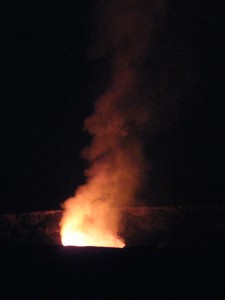 In the evening, we went to the Jaggar Museum overlook to see the red glow from the Kilauea caldera. It was magical. Everyone was reverently silent, in awe of what they were seeing. The white plume by day was now a fiery red. I longed to be able to see into Pele’s home and glimpse the red lava lake inside. After a long while, we broke ourselves away and went back to our campsites. We camped at Kulanaokuaiki campground in walk-in sites on a lava field away from the small main camping area. I hadn’t noticed it when I set up my tent, but Kilauea’s plume was in full view from my site. I put my foam pad on the ground and curled up in my sleeping bag so I could listen to the compete silence and watch the glow of the plume burst into a bright red and then taper off , and then grow red again. I laid out until sprinkles drove me into my tent. The morning light brought a thin black outline of the top of Mauna Loa, the rest covered in cloudy haze. As the sun rose, the clouds burned off and the full wide shape of Mauna Loa was off to the left of Kilauea’s white plume. Mauna Loa last erupted only thirty years ago. Eventually the Big Island will move off the seafloor vent and another island will start forming. Until then, we can observe the ever changing landscape of the Island of Hawaii.
In the evening, we went to the Jaggar Museum overlook to see the red glow from the Kilauea caldera. It was magical. Everyone was reverently silent, in awe of what they were seeing. The white plume by day was now a fiery red. I longed to be able to see into Pele’s home and glimpse the red lava lake inside. After a long while, we broke ourselves away and went back to our campsites. We camped at Kulanaokuaiki campground in walk-in sites on a lava field away from the small main camping area. I hadn’t noticed it when I set up my tent, but Kilauea’s plume was in full view from my site. I put my foam pad on the ground and curled up in my sleeping bag so I could listen to the compete silence and watch the glow of the plume burst into a bright red and then taper off , and then grow red again. I laid out until sprinkles drove me into my tent. The morning light brought a thin black outline of the top of Mauna Loa, the rest covered in cloudy haze. As the sun rose, the clouds burned off and the full wide shape of Mauna Loa was off to the left of Kilauea’s white plume. Mauna Loa last erupted only thirty years ago. Eventually the Big Island will move off the seafloor vent and another island will start forming. Until then, we can observe the ever changing landscape of the Island of Hawaii.

